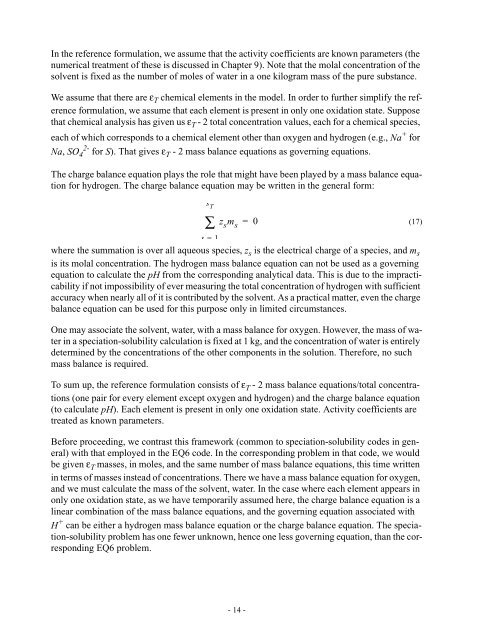EQ3NR, A Computer Program for Geochemical Aqueous Speciation ...
EQ3NR, A Computer Program for Geochemical Aqueous Speciation ...
EQ3NR, A Computer Program for Geochemical Aqueous Speciation ...
Create successful ePaper yourself
Turn your PDF publications into a flip-book with our unique Google optimized e-Paper software.
In the reference <strong>for</strong>mulation, we assume that the activity coefficients are known parameters (thenumerical treatment of these is discussed in Chapter 9). Note that the molal concentration of thesolvent is fixed as the number of moles of water in a one kilogram mass of the pure substance.We assume that there are ε T chemical elements in the model. In order to further simplify the reference<strong>for</strong>mulation, we assume that each element is present in only one oxidation state. Supposethat chemical analysis has given us ε T - 2 total concentration values, each <strong>for</strong> a chemical species,each of which corresponds to a chemical element other than oxygen and hydrogen (e.g., Na + <strong>for</strong>Na, SO 2- 4 <strong>for</strong> S). That gives ε T - 2 mass balance equations as governing equations.The charge balance equation plays the role that might have been played by a mass balance equation<strong>for</strong> hydrogen. The charge balance equation may be written in the general <strong>for</strong>m:s T∑ z sm s0=(17)s = 1where the summation is over all aqueous species, z s is the electrical charge of a species, and m sis its molal concentration. The hydrogen mass balance equation can not be used as a governingequation to calculate the pH from the corresponding analytical data. This is due to the impracticabilityif not impossibility of ever measuring the total concentration of hydrogen with sufficientaccuracy when nearly all of it is contributed by the solvent. As a practical matter, even the chargebalance equation can be used <strong>for</strong> this purpose only in limited circumstances.One may associate the solvent, water, with a mass balance <strong>for</strong> oxygen. However, the mass of waterin a speciation-solubility calculation is fixed at 1 kg, and the concentration of water is entirelydetermined by the concentrations of the other components in the solution. There<strong>for</strong>e, no suchmass balance is required.To sum up, the reference <strong>for</strong>mulation consists of ε T - 2 mass balance equations/total concentrations(one pair <strong>for</strong> every element except oxygen and hydrogen) and the charge balance equation(to calculate pH). Each element is present in only one oxidation state. Activity coefficients aretreated as known parameters.Be<strong>for</strong>e proceeding, we contrast this framework (common to speciation-solubility codes in general)with that employed in the EQ6 code. In the corresponding problem in that code, we wouldbe given ε T masses, in moles, and the same number of mass balance equations, this time writtenin terms of masses instead of concentrations. There we have a mass balance equation <strong>for</strong> oxygen,and we must calculate the mass of the solvent, water. In the case where each element appears inonly one oxidation state, as we have temporarily assumed here, the charge balance equation is alinear combination of the mass balance equations, and the governing equation associated withH + can be either a hydrogen mass balance equation or the charge balance equation. The speciation-solubilityproblem has one fewer unknown, hence one less governing equation, than the correspondingEQ6 problem.- 14 -
















